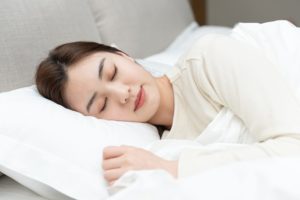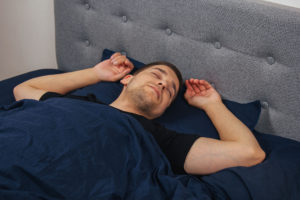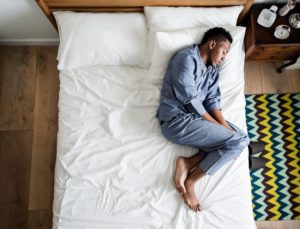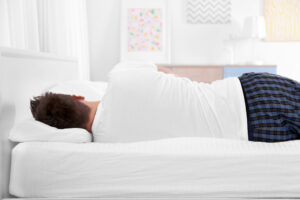Starfish Sleeping Position
- The starfish sleeping position involves lying on the back with arms stretched out.
- It may offer reduced risk of wrinkles and reduced pain, but can exacerbate snoring and sleep apnea.
- Any sleeping position should prioritize aligning and supporting the spine and ensuring restful sleep.
People sleep in three main sleep positions: side, back, and stomach. Within each sleep position, there are variations in terms of how your arms and legs are positioned . The fetal and log positions are forms of side sleeping, the freefaller is stomach sleeping, and the soldier and starfish positions are ways of back sleeping. Combined, these various ways of sleeping also create a number of sleep positions for couples.
Learn more about the benefits and drawbacks of the starfish — a back sleeping position — to determine if it’s a good choice for you.
What Is the Starfish Sleeping Position?
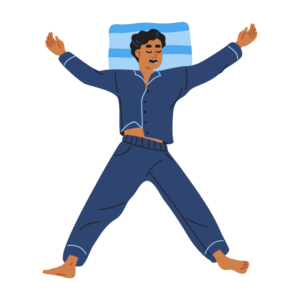
The starfish sleeping position is one in which the sleeper lies on their back, arms overhead, so their body resembles a starfish. A reported 5% of people choose this sleep position.
Benefits of the Starfish Sleeping Position
You may choose the starfish sleeping position simply because it feels comfortable, but this position offers a few health benefits.
Protects Against Shoulder Pain
Shoulder pain is common, affecting up to 47% of workers. Although it may seem counterintuitive, sleeping with your arms overhead in the starfish sleep position may protect against shoulder pain.
Researchers that specifically looked at the starfish sleep position, as opposed to back sleeping in general, found that shoulder pain was less common in starfish sleepers. Shoulder pain more commonly occurred in sleepers who chose the soldier position, which involves lying on your back with your arms by your side. These results suggest you might lower your risk of shoulder joint pain or rotator cuff tendinitis by starfish sleeping.
May Relieve Lower Back Pain
Neck and back pain are even more common than shoulder pain and, together, a leading cause of disability. Although back sleeping increases back pain for some sleepers, the position relieves back pain for others, especially when they alternate between back and side sleeping. Research demonstrates that back sleeping positions, like the starfish, help relieve lower back pain in particular.
Protects Against Neck Pain
Proper spinal alignment from your head to your hips can keep back, neck, or shoulder pain from developing during sleep. Back sleeping positions, including the starfish, naturally make it easier to keep your spine aligned. Sleeping on your back can protect against neck pain, as long as you keep your arms in a symmetrical position.
Unlikely to Cause Wrinkles
When you sleep on your stomach or your side, your face presses against your mattress or pillow. As a result, your skin may be stretched, pulled, or compressed while you sleep, which can contribute to wrinkles . When you sleep on your back, however, the only force affecting your face is gravity.
Who Is the Starfish Sleeping Position Best for?
You may benefit from the starfish sleep position if you have:
- Shoulder pain
- Lower back pain
- Neck pain
- Concerns about facial wrinkles
Even if you do not have any of these health concerns, you may simply find the starfish sleep position comfortable. Some people might want or need to choose a different sleeping position, however.

When to Choose a Different Sleeping Position
The starfish sleep position, or back sleeping in general, is not for everyone. If you experience certain health conditions, you may want to try a different sleep position.
Neck Pain
The research is divided when it comes to neck pain and sleep positions. Some research demonstrates that symmetrical back sleeping protects against neck pain. However, other research demonstrates that side sleeping, but not back sleeping, protects against morning neck pain and stiffness.
If you experience neck pain and try the starfish position, but your neck pain continues, consider trying side sleeping instead. Also, consider if the pillow you are using promotes spinal alignment in whichever position you choose. Researchers note the importance of using a pillow that is comfortable and suitable for your sleep position.
Obesity
People who are obese may also want to switch to side sleeping, since back sleeping puts more stress on the respiratory system . As you age or gain weight, you may naturally begin to prefer sleeping on your side instead of your back.
Snoring or Obstructive Sleep Apnea
If you snore or have obstructive sleep apnea, sleep experts recommend sleeping on your side or stomach instead of on your back. When you sleep on your back, it is easier for your tongue to fall back into your throat. Your tongue then creates an obstruction, restricting your airway and increasing the severity of snoring, breathing cessations associated with sleep apnea, or both.
Allergies
If you have allergies, you might want to adopt a different sleep position other than the starfish. Sleeping on your back can increase nasal congestion and sleep-disordered breathing, especially in people with allergies. These problems particularly worsen during rapid eye movement (REM) sleep.
Pregnancy
Healthcare professionals recommend pregnant people avoid sleeping on their backs, especially later in pregnancy . The back sleeping position is associated with an increased risk of stillbirth. Instead, providers recommend pregnant people sleep on their sides. Place pillows behind your back to help keep your body on your side while you sleep if you are worried you might roll onto your back as you sleep.
Additional Tips for Better Sleep
If you are a fan of the starfish sleep position, here are a few tips to enjoy a better night’s sleep.
Stay in Alignment
To enjoy good quality sleep as a back sleeper, it is important that you keep your spine aligned. Sleeping on your back makes maintaining alignment fairly easy.
However, even small asymmetries can contribute to spinal misalignment, and poorer quality sleep as a result. If you adopt the starfish position, be thoughtful about keeping your arms and legs symmetrical. Having one arm in the starfish position, as opposed to both, could contribute to neck strain.
Use a Supportive Mattress
When choosing a mattress, it is important to consider not only your price range and personal preferences, but also your sleep position. Hybrid, latex, foam, and airbed models tend to be the best mattress options for back sleepers. These models tend to offer a balanced mix of contouring and support that most back sleepers find comfortable.
After you have honed in on a mattress type, you will need to choose your firmness level. The best mattress firmness for you depends on your body weight and personal preferences. In general, studies have found that medium firm mattresses are suitable for the average person. Heavier sleepers typically find firmer mattresses to be more supportive, while lighter-weight sleepers enjoy the extra cushioning from a softer mattress.
Get the Right Pillow
The best pillow for back sleepers is generally one with a medium loft. Loft refers to the thickness, or height, of a pillow. The ideal pillow keeps your neck and head in alignment with the rest of your spine. It should provide support for your head, without arching your neck too far upward.
Medium firm pillows are often the most popular choice for back sleepers. As for material, choose whichever one feels good to you, whether that’s memory foam, buckwheat, feather, or latex.
If you’re having sleep troubles, switching to a different sleep position may help. However, if you still have difficulty sleeping, consider talking to your doctor. They can recommend additional tips for better sleep based on your personal medical history.

Still have questions? Ask our community!
Join our Sleep Care Community — a trusted hub of sleep health professionals, product specialists, and people just like you. Whether you need expert sleep advice for your insomnia or you’re searching for the perfect mattress, we’ve got you covered. Get personalized guidance from the experts who know sleep best.
References
10 Sources
-
Holdaway, L. A., Hegmann, K. T., Thiese, M. S., & Kapellusch, J. (2018). Is sleep position associated with glenohumeral shoulder pain and rotator cuff tendinopathy: A cross-sectional study. BMC Musculoskeletal Disorders, 19(1), 408.
https://pubmed.ncbi.nlm.nih.gov/30470225/ -
Sleep position gives personality clue. (2003, September 16). BBC News.
http://news.bbc.co.uk/2/hi/health/3112170.stm -
Cary, D., Briffa, K., & McKenna, L. (2019). Identifying relationships between sleep posture and non-specific spinal symptoms in adults: A scoping review. BMJ Open, 9(6), e027633.
https://pubmed.ncbi.nlm.nih.gov/31256029/ -
Lee, W. H., & Ko, M. S. (2017). Effect of sleep posture on neck muscle activity. Journal of Physical Therapy Science, 29(6), 1021–1024.
https://pubmed.ncbi.nlm.nih.gov/28626314/ -
Anson, G., Kane, M. A. C., & Lambros, V. (2016). Sleep wrinkles: Facial aging and facial distortion during sleep. Aesthetic Surgery Journal, 36(8), 931–940.
https://pubmed.ncbi.nlm.nih.gov/27329660/ -
Skarpsno, E. S., Mork, P. J., Nilsen, T. I. L., & Holtermann, A. (2017). Sleep positions and nocturnal body movements based on free-living accelerometer recordings: Association with demographics, lifestyle, and insomnia symptoms. Nature and Science of Sleep, 9, 267–275.
https://pubmed.ncbi.nlm.nih.gov/29138608/ -
Ravesloot, M. J., van Maanen, J. P., Dun, L., & de Vries, N. (2013). The undervalued potential of positional therapy in position-dependent snoring and obstructive sleep apnea: A review of the literature. Sleep & breathing, 17(1), 39–49.
https://pubmed.ncbi.nlm.nih.gov/22441662/ -
Berson, S. R., Klimczak, J., Prezio, E. A., Hu, S., & Abraham, M. (2018). Clinical associations between allergies and rapid eye movement sleep disturbances. International Forum of Allergy & Rhinology, 8(7), 817–824.
https://pubmed.ncbi.nlm.nih.gov/29461689/ -
O’Brien, L. M., & Warland, J. (2014). Typical sleep positions in pregnant women. Early Human Development, 90(6), 315–317.
https://pubmed.ncbi.nlm.nih.gov/24661447/ -
Jacobson, B. H., Boolani, A., Dunklee, G., Shepardson, A., & Acharya, H. (2010). Effect of prescribed sleep surfaces on back pain and sleep quality in patients diagnosed with low back and shoulder pain. Applied Ergonomics, 42(1), 91–97.
https://pubmed.ncbi.nlm.nih.gov/20579971/





